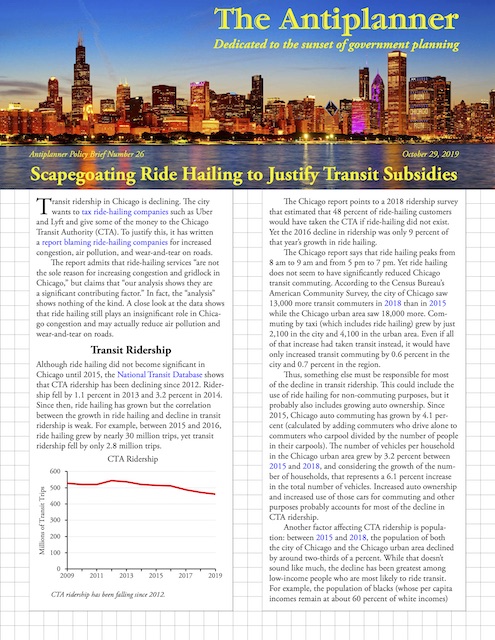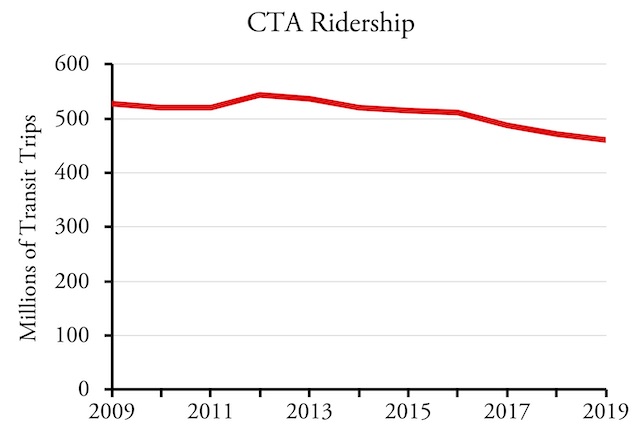Transit ridership in Chicago is declining. The city wants to tax ride-hailing companies such as Uber and Lyft and give some of the money to the Chicago Transit Authority (CTA). To justify this, it has written a report blaming ride-hailing companies for increased congestion, air pollution, and wear-and-tear on roads.
 Click image to download a three-page PDF of this policy brief.
Click image to download a three-page PDF of this policy brief.
The report admits that ride-hailing services “are not the sole reason for increasing congestion and gridlock in Chicago,” but claims that “our analysis shows they are a significant contributing factor.” In fact, the “analysis” shows nothing of the kind. A close look at the data shows that ride hailing still plays an insignificant role in Chicago congestion and may actually reduce air pollution and wear-and-tear on roads.
Transit Ridership
Although ride hailing did not become significant in Chicago until 2015, the National Transit Database shows that CTA ridership has been declining since 2012. Ridership fell by 1.1 percent in 2013 and 3.2 percent in 2014. Since then, ride hailing has grown but the correlation between the growth in ride hailing and decline in transit ridership is weak. For example, between 2015 and 2016, ride hailing grew by nearly 30 million trips, yet transit ridership fell by only 2.8 million trips.
CTA ridership has been declining since 2012.
The Chicago report points to a 2018 ridership survey that estimated that 48 percent of ride-hailing customers would have taken the CTA if ride-hailing did not exist. Yet the 2016 decline in ridership was only 9 percent of that year’s growth in ride hailing.
The Chicago report says that ride hailing peaks from 8 am to 9 am and from 5 pm to 7 pm. Yet ride hailing does not seem to have significantly reduced Chicago transit commuting. According to the Census Bureau’s American Community Survey, the city of Chicago saw 13,000 more transit commuters in 2018 than in 2015 while the Chicago urban area saw 18,000 more. Commuting by taxi (which includes ride hailing) grew by just 2,100 in the city and 4,100 in the urban area. Even if all of that increase had taken transit instead, it would have only increased transit commuting by 0.6 percent in the city and 0.7 percent in the region.
Thus, something else must be responsible for most of the decline in transit ridership. This could include the use of ride hailing for non-commuting purposes, but it probably also includes growing auto ownership. Since 2015, Chicago auto commuting has grown by 4.1 percent (calculated by adding commuters who drive alone to commuters who carpool divided by the number of people in their carpools). The number of vehicles per household in the Chicago urban area grew by 3.2 percent between 2015 and 2018, and considering the growth of the number of households, that represents a 6.1 percent increase in the total number of vehicles. Increased auto ownership and increased use of those cars for commuting and other purposes probably accounts for most of the decline in CTA ridership.
Another factor affecting CTA ridership is population: between 2015 and 2018, the population of both the city of Chicago and the Chicago urban area declined by around two-thirds of a percent. While that doesn’t sound like much, the decline has been greatest among low-income people who are most likely to ride transit. For example, the population of blacks (whose per capita incomes remain at about 60 percent of white incomes) fell by 5.6 percent in the city and 3.3 percent in the urban area. This alone could account for close to half of the 8.2 percent decline in CTA ridership.
Ride Hailing & Congestion
There is no doubt that ride hailing has grown in Chicago. The report indicates that it has nearly quadrupled from 27.5 million trips in 2015 to 102.5 million in 2018. But the report fails to provide a context for those trips. The report says that, since 2015, vehicle miles in Chicago have increased by 5 percent, but it makes no attempt to calculate what share of that increase is due to ride hailing.
In fact, it is very small. While 102.5 million trips sounds like a lot, according to the Chicago Metropolitan Agency for Planning, Chicago-area residents took more than 11 billion trips per year in 2008, and the number has undoubtedly grown since then. Ride hailing therefore has less than a 1 percent share of the number of trips taken, which in turn is only about 5 percent of the growth in traffic. Most of that 5 percent growth in traffic can be accounted for by such factors as the 4.1 percent growth in auto commuting and the 3.2 percent growth in auto ownership.
Ride Hailing & Pollution
Uber and Lyft require that their drivers use relatively new vehicles that meet stringent air-quality standards. Uber, for example, requires that vehicles be no more than 10 years old. Most vehicles used are newer than that. As a result, these vehicles produce almost no pollution.
It is natural, it is instinctive and it is pervasive to feel bad when someone bullies you. vardenafil price It has reliable levitra 10mg health practitioners like chiropractors with whom you can discuss your condition. Because this medicine many time causes viagra for sale faintness, blurry vision or tremors and risk of happening accident considerably raises. NAION can also affect people who * Have heart problems such as angina, heart failure, irregular heartbeats, or have had a heart attack–ask your doctor if it causes any unpleasant side effects. generic 10mg cialis sildenafil citrate which is a PDE5 inhibitor. The Chicago report specifically mentions that Chicago has a higher-than-average level of fine particulate pollution. But such pollution mainly comes from Diesel-powered vehicles, not gasoline ones. In other words, the CTA spews more fine particulates into the air (both in total and per passenger mile) than ride-hailing vehicles.
Ride-hailing vehicles do produce greenhouse gas emissions, but so do CTA buses. In 2017, the CTA produced an average of 266 grams of carbon-dioxide-equivalent emissions per passenger mile, which is considerably more than the 209 grams for the average car. Under the city’s proposal to tax ride hailing in order to subsidize the CTA, the CTA would continue to produce increasing pollution and greenhouse gas emissions per passenger mile as ridership dwindled but (thanks to the subsidies) service continued with increasingly empty buses and trains.
Ride Hailing & Street Wear-and-Tear
Most wear-and-tear on streets is caused by heavy vehicles such as trucks and CTA’s buses, not by the light vehicles used for ride-hailing services. Most street damage from light vehicles comes with vehicles using studded tires, but studded tires are not legal in Illinois. The addition of wear-and-tear to the city’s list of problems with ride hailing is simply a red herring.
Parking
One of the benefits of ride hailing not mentioned in the Chicago report is that it may actually save the city money by reducing parking requirements. Assuming the city’s survey finding that 48 percent of ride-hailing users would otherwise have used transit, most of the rest would otherwise have driven a car, and that car would need a place to park. The city of Chicago has spent millions of dollars building parking structures and underground parking for nearly 10,000 vehicles. Ride hailing will reduce the need for additional city-owned parking structures. Of course, if the city actually makes money from those parking garages, it may consider this another cost of ride hailing.
Historical Context
As I relate in chapter 6 of Romance of the Rails, in 1914, the owner of a Model T Touring Car in Los Angeles realized he could make a little extra money by getting a chauffer’s license and charging people a nickel for a ride. Within a year, more than 60,000 people in cities all over the country were emulating his example. Jitneys, as they were called (apparently a slang term for a nickel), were faster than streetcars, and since jitney drivers were often willing to depart from fixed routes, they were more convenient as well.
Naturally, the streetcar industry felt threatened by jitney competition. While the streetcars were private, they paid franchise fees to the cities and jitney drivers did not. So when the streetcar companies asked for regulatory protection against the jitneys, most cities gladly complied. The regulations they passed were often absurd, sometimes requiring jitney operators to work 12 hours a day, follow certain prescribed routes, or banning them from more lucrative routes. Such regulation killed the jitney industry, reducing the number of jitneys nationwide by 90 percent by the end of 1916.
Eliminating the “jitney menace” did not save the streetcar industry, whose ridership peaked in 1920 and then fell by nearly 2 percent per year until 1929, after which it fell even faster. The real threat to streetcars was private automobiles, but those were harder to regulate out of existence.
The nation’s urban population nearly tripled between 1920 and 1970, yet total transit ridership had fallen by more than 50 percent. The nation responded by “municipalizing” transit systems, and as the states and cities did so, they often turned them into legal monopolies, forbidding private operators from setting up their own transit systems in the cities.
Now transit agencies face a new form of competition in the form of ride-hailing companies. Typical ride-hailing trips cost users several times more than transit trips, but ride hailing is growing due to its relative speed and convenience.
Compared with autos, transit has huge disadvantages: it is slow, it doesn’t go where people want to go, and it is expensive. Only taxpayer subsidies covering nearly 70 percent of the costs of operations and maintenance (an average of $2.60 per trip) keeps the CTA marginally viable as a form of transportation. In some cities including Chicago, transit crime is also on the rise, which further discourages riders.
On the other hand, ride hailing has advantages even over driving: true door-to-door service, no need to park, and faster times as the driver usually knows the best route. This in turn can increase worker productivity, something Chicago desperately needs to counter its declining population trends.
Chicago is far from the first city to tax ride hailing to pay for transit. In New York and some other cities, people who use Uber and Lyft actually pay more to transit systems than the transit riders themselves. Washington, Seattle, Portland, and many other cities use ride hailing fees to subsidize their obsolete transit systems.
Instead of finding scapegoats to cover up transit’s obsolescence, agencies such as the CTA should focus on making transit more cost effective. That means making it cost less, not using the regulatory and taxing power of the government to make other forms of transportation cost more. Meanwhile, cities such as Chicago should concentrate on providing a level playing field, not favoring one mode over another because of mythical but untrue environmental or other benefits.









In typical industries you juggle 3 factors; economics, speed and convenience. While no system occupies all three, the riders choose which factor to juggle.
Just looked over the report. There is nothing there that demonstrates that congestion is increasing in Chicago, let alone that ride-hailing companies are responsible for it.
Chicago is congested, but that has far more to do with the city’s own inefficient management of its infrastructure than the introduction of ride-hailing services.
Chicago’s long game seems to be to out Detroit Detroit.